Types of Pine Cones: Large, Small, Giant, and More (with Pictures) – Identification Guide
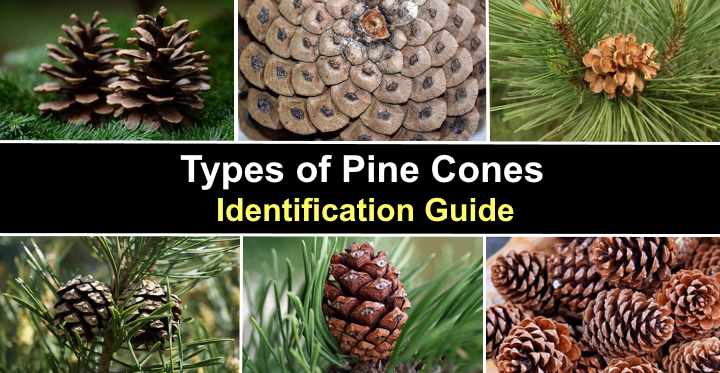
Pine cones come in all shapes, sizes and shades of brown. The conical or cylindrical woody cones help identify the species of pine trees. Most pine cones have an overall cone-like or egg shape. Some seed cones from pine trees are long and cylinder-like, whereas other pine cones are more egg-shaped with woody spiny scales. Some of the smallest pine cones are barrel-shaped with large scales. The largest pine cone — the coulter pine cone — is a huge ovoid scaly cone that weighs up to 11 lbs. (5 kg).
All coniferous trees produce cones, but pine cones only come from pine trees in the genus Pinus. Seed-containing pine cones are not only necessary for a pine tree to reproduce. Pine cones contain edible seeds or nuts, and pine cones are also highly decorative.
This article is an identification guide to recognizing various types of pine cones. You will learn about the heaviest, largest, smallest, and longest pine cones. In addition, descriptions and pictures of pine cone features will help identify these seed-containing cones.
What Are Pine Cones?
Pine cones play a vital role in a pine tree’s reproduction. Each cone or strobilus contains woody bracts or scales connected to a central stem that protects pine nuts or seeds. Some pine tree species contain male and female cones, whereas others only produce one or the other.
Male vs. Female Pine Cones
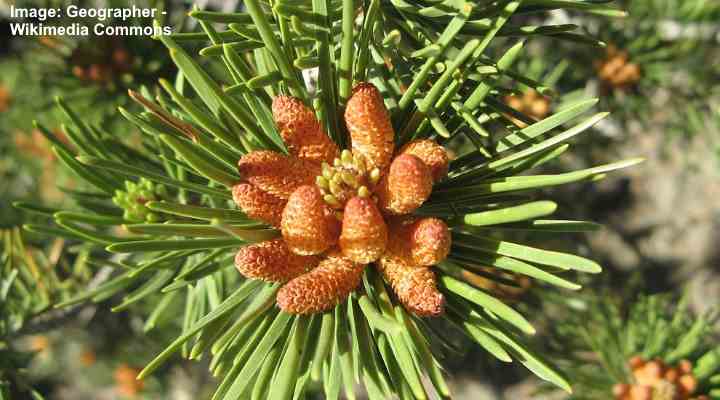
Male cones of lodgepole pine (Pinus contorta subsp. murrayana)
The difference between male pine cones and female cones is in their size, shape, and color. Female pine cones are the characteristic woody, scaly ovoid cones that dangle visibly on pine trees. Male pine cones are the smallest types of pine cones. Male pine cones are yellowish, tube-like clusters with close-knit scales that contain pollen. As a result, male cones are difficult to spot on pine trees.
Male pine cones are small cylindrical structures that release pollen. Larger female cone scales open to receive pollen and then close as the pine seeds or nuts develop and mature in the cones. Typically, pictures of pine cones only show female cones.
Pine Cone Seeds
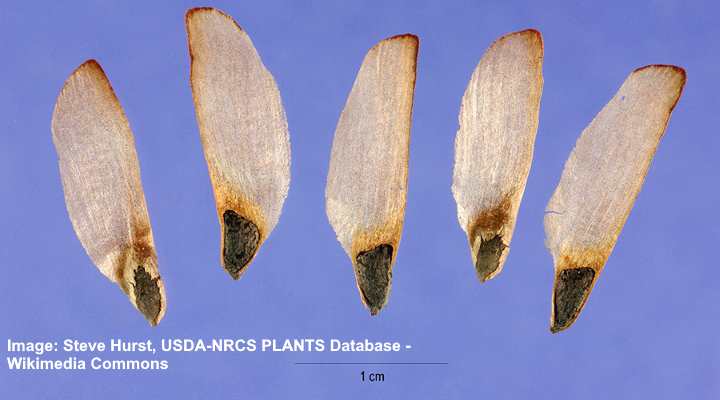
Seeds of sand pine (Pinus clausa)
Seeds in female pine cones have a single wing with a tear-shaped seed at the base. Pine seeds are encased in an inedible hard shell. The papery wing of the pine cone seed disperses them in the wind when the pine scales or plates open. There are typically two seeds per scale.
Do Pine Nuts Come From Pine Cones?
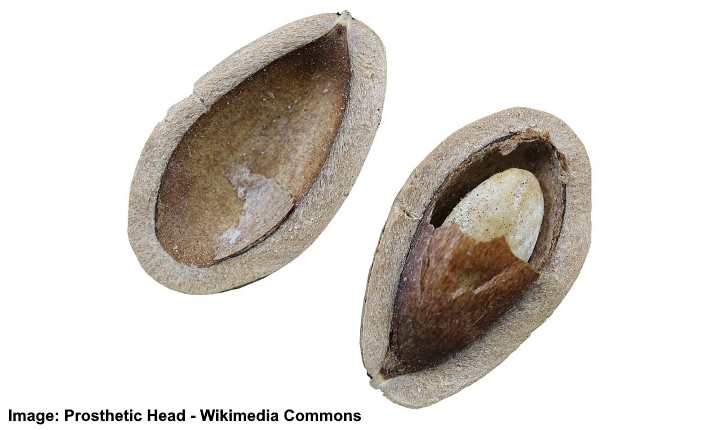
A close up picture of pine nut in opened shell
Pine nuts are the edible seeds that come from certain types of pine cones. The edible pine nuts have a sweet, nutty flavor and are often toasted to enhance their flavor.
The small ivory-white pine nut is an oval or oblong shape and measures about 0.5” (12 mm) long. Also called pignoli, the white pine nut has a rigid casing.
Although there are over 115 species of pine, only around 20 produce pine nuts suitable for harvesting.
The best and tastiest pine nuts come from the Pinyon pine tree (Pinus edulis). The delicious pine nuts are said to have a soft, nutty flavor with sweet overtones. Some say that pine nuts straight off the tree have a similar taste to cashew nuts.
Pine Cone Facts
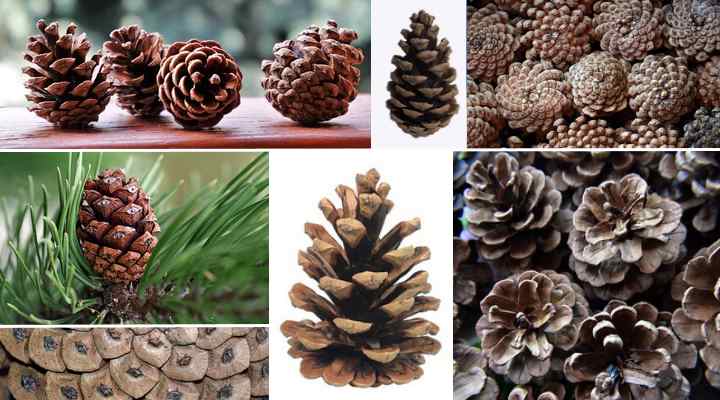
Pine cones come in various shapes and sizes
Pine cones open and close several times throughout the season. The cones’ scales open for fertilization and seed dispersal.
Pine cones can remain on the tree for more than ten years. However, most types of cones from pine trees mature in six to eight months, depending on the species. But some take up to two years to reach maturity.
The wind disperses pine seeds. Pine cone scales open in dry weather, allowing the wind to carry seeds far from the tree. This fact ensures greater pine tree species diversity.
Pine cones range in size from small, stumpy barrel-shaped cones measuring around 0.8” (2 cm) to long cylinder-like cones measuring 20” (50 cm) long. Pine cones can have thin papery scales or thick woody scales, depending on the species.
Pine cones can also indicate levels of humidity in the air. Pine cones usually close up when damp and then open when it’s dry. Additionally, cones that are opened or closed on the ground also indicate how dry the ground is, and, therefore, if there’s a risk of forest fire.
Pine Cone Identification
A pine cone is identified by its shape, size, and color. For example, the woody, scaly tan-colored cone usually has an overall conic, ovoid (egg-shaped), or cylindrical shape. In addition, the cones typically have a rough, warty texture when closed. Some cones have upward growing scales when open, whereas others spread horizontally.
Types of Pine Cones (with Pictures) – Identification
Let’s look in more detail at identifying common types of pine cones that you are likely to come across in a forest containing conifers and pine trees.
Coulter Pine Cone (Pinus coulteri)
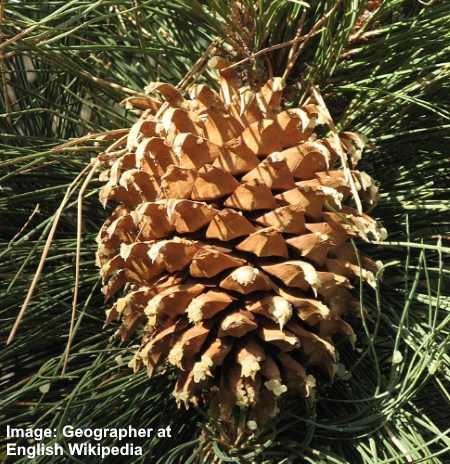
The heavy coulter pine cone is one of the world’s largest pine cone
Pine cones from the coulter pine tree are identified as the largest and most massive of all pine cones. The huge cones have an ovoid to cylindrical shape and measure 8″ – 16″ (20 – 40 cm) long. The pale brown cone weighs between 4 and 11 lbs. (1.8 – 5 kg).
Due to their size and weight, the coulter pine cone is also called the “widowmaker.” One of these ginormous spiky pine cones can do severe damage if one falls on your head.
Male coulter pine cones have a slender cylinder shape that measures up to 1” (25 mm) long. The small pine cones range in size from orange-brown to purple-brown.
Pinyon Pine Cone (Pinus edulis)

Pinyon pine cones produce delicious pine nuts
Pine cones from the pinyon pine tree are said to produce the tastiest pine nuts. The pale yellowish-brown or reddish-brown pine cones have a globose shape with relatively large scales. The resinous cones measure 1.2” to 2” (3 – 5 cm) long and up to 2.4” (6 cm) broad when open.
Pinyon pine cones take two years to mature, and usually birds disperse the seeds. The pine nuts in their hard shells are egg-shaped and don’t have wings.
Male pine cones are some of the smallest pine cones from all the native pine trees. They are identified by their yellowish to rusty brown color and measure around 0.28” (7 mm) long.
Monterey Pine Cone (Pinus radiata)
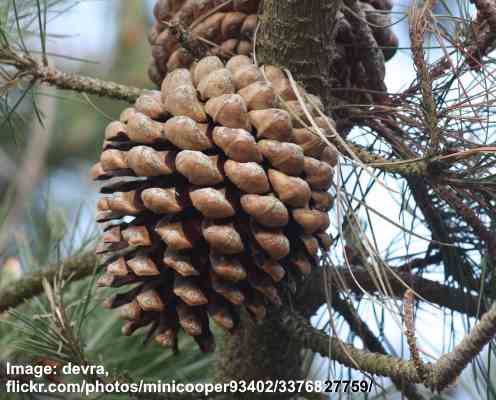
The large Monterey pine cones are commonly seen in coniferous forests
Pine cones from the Monterey pine tree are among the most popular cones. The pine cones are identified by their light brown color and egg shape. The woody scales have recurved tips, and each contains a winged, dark-brown seed. The pine cones measure 3” to 6” long (7.5 – 15 cm).
Evergreen Monterey pine trees are the most widely-grown pine trees for timber in North America. Apart from the large, tan-colored cones, identifying features of the pine tree include reddish-brown bark, cylindrical male pollen cones, and a loose pyramidal crown.
Lodgepole Pine Cone (Pinus contorta)
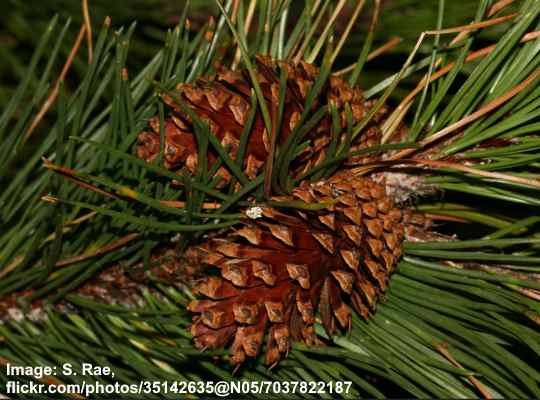
Lodgepole pine cones
Pine cones from the lodgepole pine tree are conical before opening to a rounded to oval shape in an orangey-red or tan color. Lodgepole pine cones are 1” to 3” (2.5 – 7.5 cm) long and contain several winged black seeds. The slender egg-shaped cones grow on pine trees up to 160 ft. (50 m) tall.
Pollen cones on the lodgepole pine tree are tiny, cylindrical cones measuring 0.2” to 0.6” (5 – 15 mm) long. Other identifying features of lodgepole pines are gray or reddish-brown bark, yellow-green needles leaves, and black-winged seeds measuring 0.4” (1 cm) long.
Bristlecone Pine Cone (Pinus longaeva)
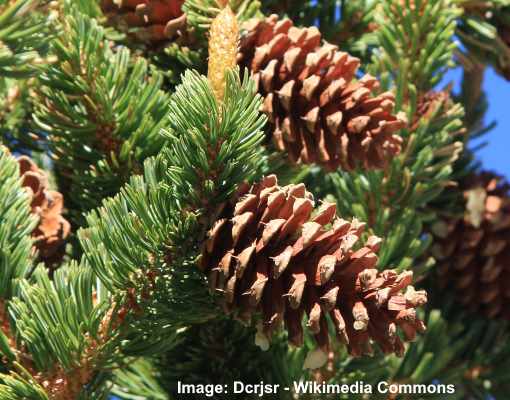
Bristlecone pine cones are identified by the small spine on each scale
One of the longest-living types of pine cones grows on the bristlecone pine tree. The pine cones have an ovoid to a cylindrical shape and measure 2” to 4” (5 to 10 cm) long. The cones emerge green or purple and mature to an orange-brown color.
When mature, bristlecone pine cones have bristle-like spines and open up to become 1.5” to 2.5” (4 to 6 cm) wide. The pear-shaped, pale brown seeds measure 0.2” to 0.32” (5 – 8 mm) and a wing 0.5 (12 mm) long.
Sugar Pine Cone (Pinus lambertiana)
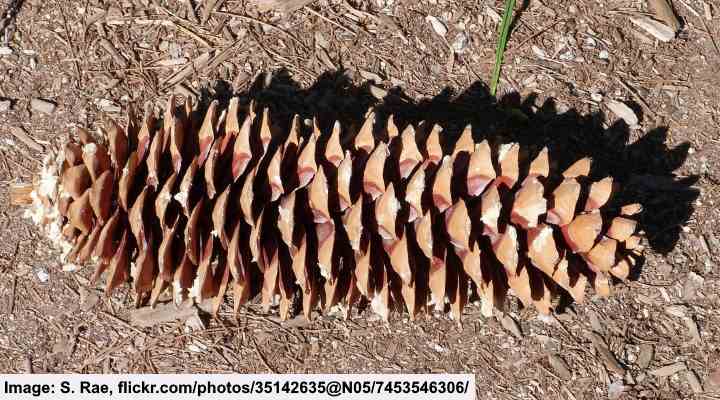
Sugar pine cone is the longest of all pine cones
Pine cones from the sugar pine trees are identified as the longest seed cones of any conifer species. The long, cylindrical scaly pine cones average 10” to 20” (25 – 50 cm) in length. In some cases, the long cylinder cones reach 26” (66 cm) long. The cones have flattened, light-brown colored scales.
The exceptionally long brown cones grow on one of the largest pine trees. The sugar pine can grow 130 – 200 ft. (40 – 60 m) tall and has a recognizable, narrow, conical flat-topped crown that helps to identify the tree apart from other pines.
Eastern White Pine Cone (Pinus strobus)

The eastern white pine cone is long and slender
Pine cones from the eastern white pine tree are slender, cylindrical resinous seed cones that grow 3” to 6” (7.5 – 15 cm) long. The easily identifiable pine cones have open scales with a rounded apex and reflexed tip. The cone’s scales contain tiny seeds measuring 0.2” (5 mm) long.
Also called the white pine tree, the coniferous tree is identified by its whitish-gray bark. The tree’s needle leaves grow in bundles of five and have a bluish-green color. The most common identifying feature of the Eastern white pine is the long slender brown cones dangling between evergreen leaves.
Western White Pine Cone (Pinus monticola)
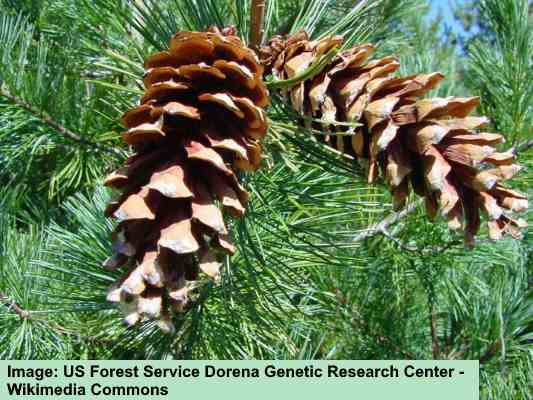
The western white pine tree has long pine cones
Pine cones from the western white pine are identified as lance-shaped or cylindric seed cones in a creamy-brown color. The long pendulous pine cones measure 4” to 5” (10 – 25 cm) long and have thin, flexible scales. You’ll notice the cylindrical cones growing in clusters on the trees.
Apart from clusters of hanging pine cones, other identifying features of the western white pine include bluish-green needle leaves, smooth thin gray bark, and a narrowly conical crown. The tiny male cones are oval, yellow, and measure 0.4” to 0.6”(10 – 15 mm) long.
Ponderosa pine Cone (Pinus ponderosa)
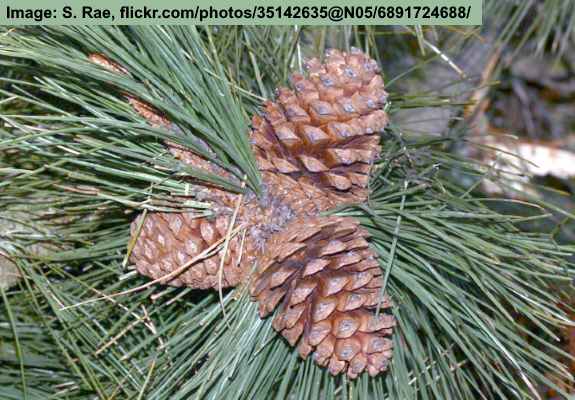
Ponderosa pine cone are usually reddish-brown in color
Pine cones from the ponderosa pine tree are small to medium size, dark-brown, egg-shaped seed cones that mature in 2 years. The ovoid pine cones have thick scales that grow spirally. Each pine cone measures 2” to 6” (5 – 15 cm), and between each scale is a yellowish-brown pear-shaped seed.
Also called the blackjack pine, western yellow pine, or filipinus pine, this tall conifer is identified by its reddish, scaly bark. The slender, erect tree is also recognized by its purplish cones when they appear and gradually become brown. There is typically an abundance of cones on the ground under this pine tree.
Scots Pine Cone (Pinus sylvestris)

Scots pine cones are small and have rounded form
Pine cones on the Scots pine tree are pointed, ovoid-conic cones that emerge red and gradually turn a pale brown color. Scots pine cones have flat, pyramidal scales containing dark brown or black winged seeds. The Scots pine cones measure 1.2” to 3” (3 – 7.5 cm) long.
Apart from being identified by the open, woody scales, a Scots pine tree has a recognizable straight reddish-brown, branchless trunk with a pyramidal crown at the top of the tree. Male cones are yellow or pink but are hard to spot at the top of the tall 110 ft. (35 m) tree.
Mountain Pine Cone (Pinus mugo)
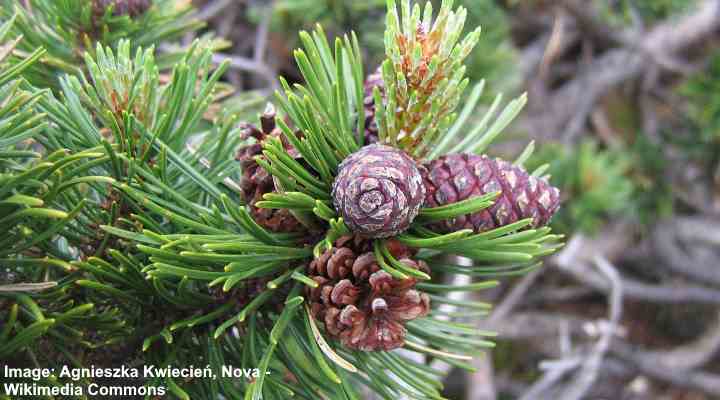
Closed and open cones of mountain pine tree
Pine cones on the mountain pine tree are identified as small, symmetrical, barrel-like cones that grow up to 2” (5 cm) long and 1.12” (2.8 cm) wide. Mountain pine cones emerge purple and mature to a dark brown color. The cone’s scales are thin, flat, and triangular, each containing black winged seeds.
Mountain pine trees are small, shrub-like conifer trees that produce pine cones. Other names for this dwarf pine tree include creeping pine, scrub mountain pine, or dwarf mountain pine. The coniferous trees don’t usually grow more than 10 to 18 ft. (3 – 5 m) tall.
Red Pine Cone (Pinus resinosa)
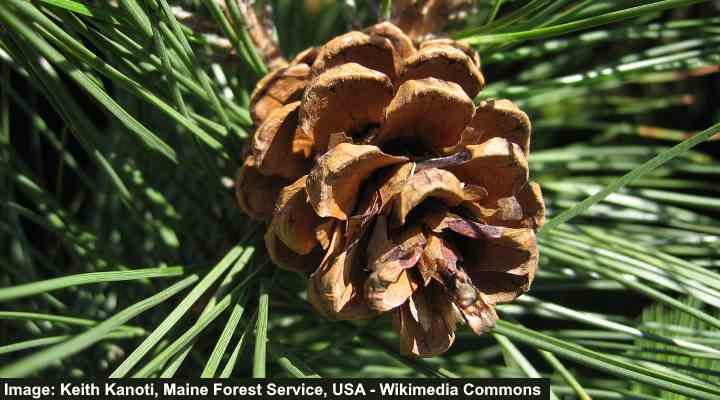
Red pine cone are small and egg-shaped
Pine cones on the red pine tree are small, egg-shaped reddish-brown seed cones that become almost globose when they open. The spreading, open cones grow 1.5” to 2.5” (3.5 to 6 cm) long. Like many cold-hardy pines, the ovoid cones emerge purple and ripen to a nut-brown color.
A characteristic trait of a red pine tree is its tall, straight trunk, smooth grayish-brown bark with red colors in the fissures, and a narrow, conical crown. The red pine cones grow singularly or in opposite pairs and mature two years after pollination.
Jack Pine Cone (Pinus banksiana)
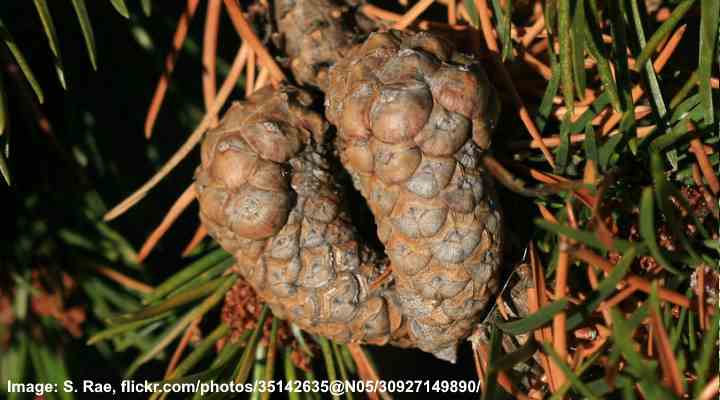
The unique shape of Jack pine cones helps to identify the tree
Cones on the native jack pine tree are unusual looking because of their curved tip when closed. The smooth pine cones have a yellowish-gray color that develops to a nut-brown color. The distinctive pine cones open in extreme heat. These conical, curved pine cones measure around 2” (5 cm) long.
A unique feature of jack pine cones is that the cones point forward along the branch, rather than the traditional dangling cones of most pine tree species. Therefore, looking at the cones’ growth habit can help identify jack pine cones apart from other pine trees.
Virginia pine Cone (Pinus virginiana)

Virginia pine cone have a prickle on each scale
Pine cones on a Virginia pine tree are narrow, egg-shaped brown seed cones with a reddish-brown color. The medium-sized, attractive pine cones measure 1.6” to 2.8” (4 – 7 cm) long and can stay on trees for several years. The pine cones have identifiable prickles on the spreading scales.
Apart from the ovoid pine cones, identifying features of the Virginia pine tree are short, twisted needle leaves growing in pairs, rough, reddish bark, and medium size of 30 – 60 ft. (9 – 18 m).
How to Plant Pine Cone Seeds
Growing a pine tree from seed is possible, albeit challenging. You can harvest the pine seeds from pine cones that have fallen to the ground in late fall. You can identify the pine seeds as a small, winged structure nestled between pine cone scales.
To extract the winged pine seeds, shake the pine cones upside down. Then put the pine seeds in a bowl of water and collect the seeds that sink to the bottom. Next, you can plant the pine seeds in the ground immediately or dry them and store them in an airtight container.
To germinate pine seeds indoors, put a seed in a small pot filled with well-drained potting soil. You should push the pine seed just below the surface, with the apex pointed downward. Then, put the pots on a sunny windowsill and keep the soil moist. It should take a few months for seeds to sprout.
Once pine seedlings are between 6” to 12” (15 – 30 cm) tall, you can transplant them to your garden.
Discover the many types of pine trees and learn how to identify them.
Related articles:
